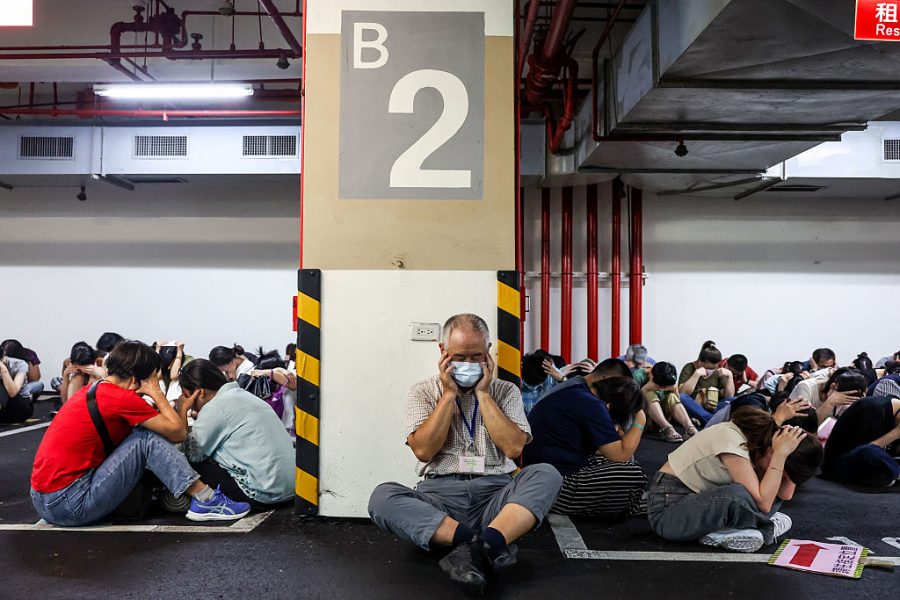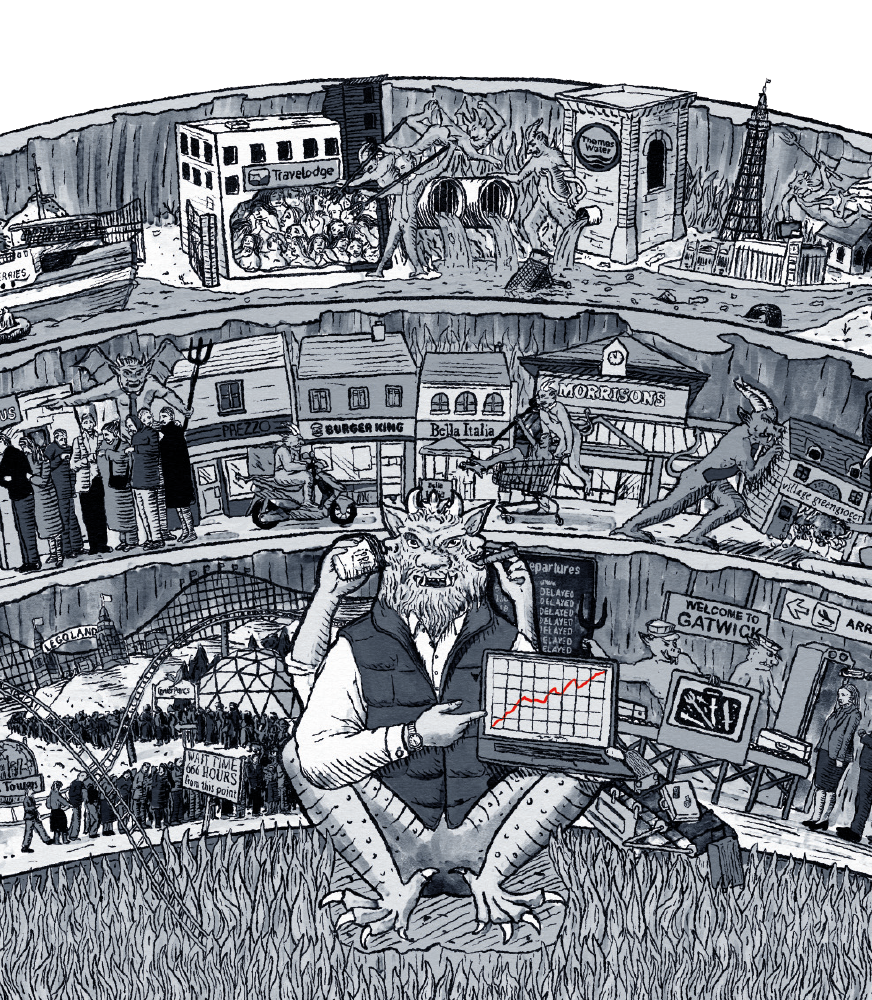It’s still lunchtime in Taipei but the streets are strangely quiet. A few people are running with their bags, despite the sweltering summer heat, desperate to get somewhere before 1.30 p.m. I’m enjoying the air-conditioning in a local supermarket when an announcement politely informs me and the only other customer still in the shop that we need to hurry if we want to buy something. The checkout assistant rushes to hand me my change, and I head back out into the heat.
The Taiwanese government is certainly taking the risk of an attack by China seriously
At precisely 1.30 p.m., my phone buzzes with a yellow alert in Chinese and English: ‘Air Defense Drill. Missile attack. Seek immediate shelter’, with a link to a map of nearby shelters. Sirens wail across the city, and a metal gate immediately drops down in front of the entrance, sealing the supermarket. ‘Where do I go?’ I ask a man standing smoking outside. He shrugs: ‘Just find somewhere to stay for half an hour.’
I hurry towards the nearest metro station down a narrow street. It is deserted, save for a few old ladies still washing up in their restaurants; the policeman in a high-vis jacket hasn’t made it to this end of the street yet, but presumably they’ll soon be told to find places to shelter.
Another police officer helps an old lady with limited mobility into the reception of a nearby office building, and instructs me to follow her. A sign says the lift will not operate during the drill; people of all ages sit on plastic chairs in the foyer, looking at their phones. One holds an electric fan to her face as she scrolls on her phone. Two friends chat and laugh. I glance around and then at the glass window next to me, wondering whether, in the case of a missile strike, I’d actually be safer outside.
A few of us – all men – stand and take in the sight of a main road in the very heart of Taipei, completely still. The eerie calm is punctuated every few minutes by ambulances heltering down the road; hopefully that’s part of the drills. A security guard of perhaps 60 grins at me and strikes up a conversation in English. ‘This is a good experience for you!’ he says. I ask how he feels about the drills. ‘This is necessary at the moment because we have one bad neighbour,’ he muses with a chuckle. Is he afraid? ‘Taiwanese never scared,’ he replies.
He might not be, but others I speak to certainly are. Many, though, seem disinterested and nonchalant. A few complain about the disruption, but others just find ways to pass the half hour and then carry on with their lives. Minutes after the second alert announces the end of the drill, the streets bustle once more and queues are forming outside the ubiquitous takeaway tea shops.
The Taiwanese government is certainly taking the risk of an attack by China seriously. The annual military exercises this year lasted ten days instead of five, and included civilian air defence drills across Taiwan. The military mobilised 22,000 troops – the most ever – including an entire brigade. Once an entirely scripted affair, the drills now include much more realistic training scenarios, such as units being cut off from their superiors. Taiwan’s vice president Hsiao Bi-khim described this year’s drills as a ‘significant step forward’.
Do the drills mean Taiwan views conflict with China as likely? Dr Jyun-Yi Lee from the government-funded INDSR military think tank tells me calmly: ‘Taiwanese society accepts the possibility of a worst-case scenario, and we are preparing for that.’ That does not mean it is probable. Nor is a full-scale invasion unpredictable: Dr Lee’s colleague Dr Jyh-Shyang Sheu gives me a long list of likely indicators of preparations Taiwan would look for, like troop movements or cancelling leave, many of which Taiwanese military intelligence can track.
A full-scale invasion is the most extreme scenario the drills covered. This starts with defending possible landing beaches, but also other scenarios like protecting the main international airport and key bridges on the approach to Taipei. Should the labyrinthine Hengshan command centre nestled under the mountains north of Taipei ever fall, the military practised defending its alternative command centre west of the city. If it ever came to it, there’s also an enormous underground airbase complex in a hollowed-out mountain on the East coast.
This year, the military practised close-quarters fighting in cities in Taiwan, a tacit acknowledgement that any fighting would not necessarily be limited to the beaches. Local media this week is full of surreal images of drills in urban settings: tanks near a Costco, or military police running out of Taipei’s spotless metro late at night carrying anti-tank missiles. It has not been entirely smooth: the dense urban sprawl of Taiwan’s cities is a nightmare to navigate with large military equipment. Several cars have been damaged by tanks, and at one point an anti-aircraft missile got caught in the awning of a noodle shop. But if it’s difficult for the Taiwanese military, imagine how difficult it would be for the Chinese.
Military analysts in Taipei view a full-scale invasion as highly unlikely in the near term. But Beijing has less risky possible strategies that are more obviously within its capabilities. One is a sudden lightning assault on the Taiwanese government. To do so, Chinese vessels would presumably sail up the Tamsui river, which in the last two weeks the Taiwanese military has practised blockading.
Another would be an escalation of the kind of ‘grey zone’ tactics – pressure or harassment that falls short of war – it already uses against Taiwan. China deploys aircraft near the island almost daily. One expert says that this year’s drills seemed to have practised how Taiwan would respond to Chinese vessels intruding its territorial waters, possibly including using its newly tested sea drones.
Drones, both aerial and sea, are part of Taiwan’s asymmetric strategy. With its rock-bottom birth rate and a military budget a fraction of that of its adversary, many see unmanned systems as the answer. If Taiwan can mass-produce enough cheap drones, the thinking goes, it can cheaply make an invasion unacceptably costly for China. Photos from the president’s office show that drones have been used in this year’s drills, but much about how the Taiwanese military would use them in case of a conflict remains unclear or undecided.
Do these drills make the threat feel real? Dr Lee is sceptical. ‘I don’t think it is real enough. People don’t have a sense of urgency.’ Even the military researchers at INDSR didn’t take it that seriously. ‘We were [in the air-defence shelter] chatting, we weren’t really practising how to protect ourselves if there’s an airstrike.’







Comments